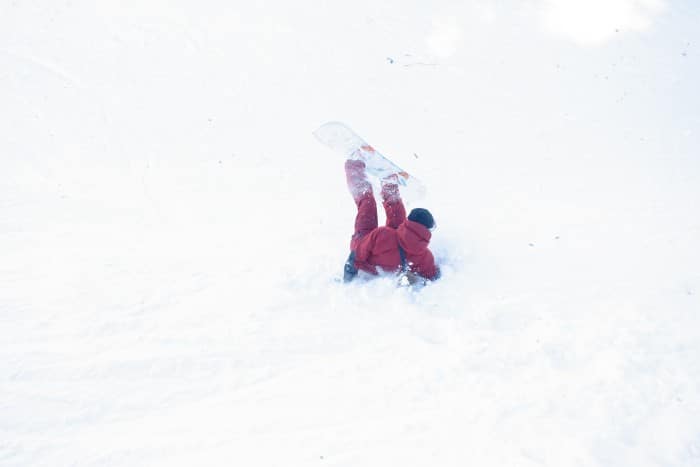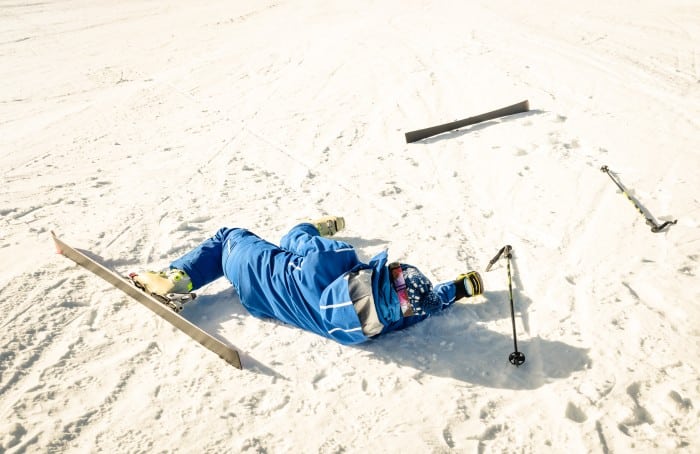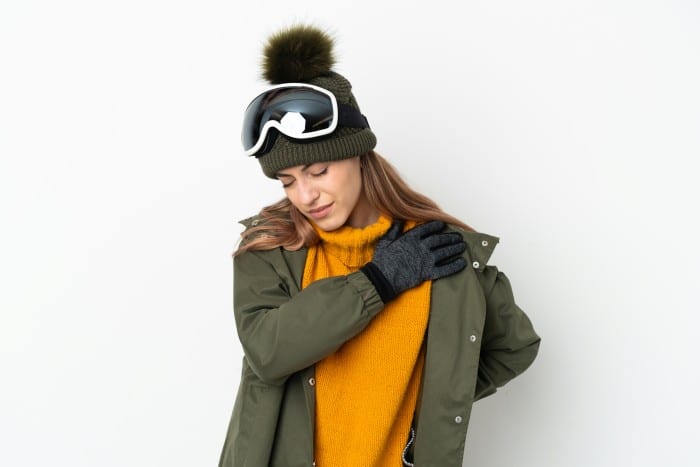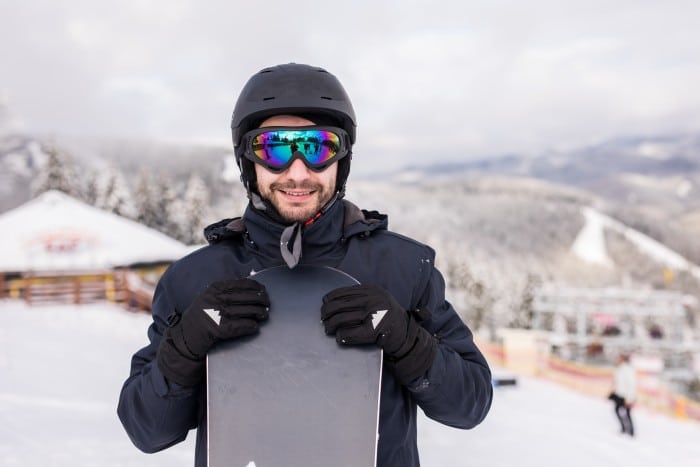On the slopes, there’s a common lighthearted battle of snowboarders against skiers. One source of comparison between the two is the rate of injury in both sports.
Snowboarding and skiing both have a relatively low rate of injury. However, of the two, snowboarding has a higher risk of injury. Skiing has a higher rate of death, but the two sports are very safe to engage in, provided that you take all the necessary precautions and safety measures.
Below, we detail the differences between the two hobbies regarding their danger level and how to avoid injury when skiing or snowboarding.
Is Snowboarding More Dangerous Than Skiing?
Snowboarding may be more dangerous than skiing, depending on your perspective. Snowboarders are more likely to get injured than skiers but are less likely to die on the slopes, and this makes the two hobbies difficult to thoroughly compare and gauge an accurate description of which sport is riskier.
Snowboarders are likelier to try dangerous tricks than skiers, putting them at a higher risk of injury, as a quarter of all snowboarding injuries are from attempts to do various tricks.
This is due to the increased risk of injury when trying out tricks.
The more intense and showy tricks you do, the more you exert your body and the more you feel its effects.
Snowboarders try out tricks more often because of the board’s increased maneuverability compared to skis.
It’s harder to move and twist skis around like you’re able to move a snowboard around, making bigger tricks more challenging to implement with skis than on snowboards.

Common Causes of Injuries
While it’s impossible to be entirely safe from snowboarding or skiing injuries, you can adopt various preventative measures to keep you safe from any potential injury.
These measures involve avoiding the pitfalls listed below to the best of your ability and keeping them in mind when you’re shredding to have the safest time possible.
Common causes of injuries include not taking enough breaks throughout the day and not listening to your body.
Your body knows when it needs rest or is in pain, and making sure to listen to it is your best bet at trying to avoid injuries of any sort.
In addition, if you’re feeling tired or dehydrated, be sure to rest and drink as much water as you need, as your body will thank you for it in the long run.
Other common causes of injury include snowboarding or skiing above your ability level, not paying attention to warning signs, and having faulty equipment.
While it’s understandable to want to show off and appear cool, you must listen to the safety advice and only tackle what you can handle when on the slopes.
Also, maintaining your equipment is crucial, as there’s plenty of regular maintenance that you can do to keep yourself safe.
Snowboarding vs Skiing Injury Information
Contrary to expectation, snowboarding and skiing have a minimal risk of serious injury compared to other sports.
Snowboarders receive 4-16 injuries for every 1,000 days on the slopes, whereas skiers receive three injuries for every 1,000 days spent skiing.
A study conducted by Sports Medicine Australia found that 383 skiers were admitted to the hospital for injuries due to skiing over a three-year period.
Over a one-year period, 384 snowboarders were admitted to the hospital for snowboarding-related injuries.
As such, it’s fair to conclude that snowboarders, on average, tend to get injured more often than skiers.
While skiers are more likely to die than snowboarders, the truth is that very few people die yearly from skiing or snowboarding.
Only 41 people die annually from skiing in the US, and only 44 suffer from severe injuries.
Most of the deaths were from individuals who lacked proper training and those who overestimated their abilities and encountered objects at high speed, causing them to pay the ultimate price.
1. Skiing Safety Precautions
Skiing has various safety precautions in place that snowboarding lacks.
Skis detach from the boot, which keeps skiers safe from injuries due to the skis twisting and bending the leg into positions it otherwise wouldn’t go.
Snowboarders, on the other hand, have to get strapped into their board, meaning that they cannot eject from their board in the case of an emergency.
This furthers snowboarders’ likelihood of injury from their board compared to skiers with their skis.
However, momentum must be considered when comparing the precautions of detachable skis between the two sports.
When a skier is skiing at high speed, their skis detaching won’t stop their momentum.
Instead, they’ll maintain speed, potentially plummeting towards others or the ground.
Snowboarders, on the other hand, have a bit of an advantage when falling, as their boards gain friction from remaining attached to their feet, which will likely slow them down enough to help avoid significant injuries.

2. Knee Injuries
Snowboarders have the advantage in this department, as you are less likely to sustain knee injuries from snowboarding than from skiing.
Specifically, skiers often can tear their knee ligaments, with a high risk of tearing their ACL.
This happens because skis pull the body in two different directions when falling.
If the skis are not released from the skier’s feet, they can place a great deal of twisting force on their knees.
Another common source of injury is a torn meniscus, an injury to the cartilage within your knee.
Low-speed accidents cause a greater risk of knee injury than high-speed accidents in skiing.
This is because skis are more likely to release from the boots during a higher speed accident, which helps prevent knee-related injuries.
In addition, mogul skiing involves the knees absorbing the impact of the moguls, which can be especially tough on that part of the body.
This gradually degrades the knees of mogul skiers over time, causing severe injury and putting their bodies at significant risk.
On the other hand, snowboarders avoid these issues as they ride different terrain, often with less pivoting of the knees.
The most common knee injuries that snowboarders incur are damages to the ligaments, primarily the ACL and MCL.
These injuries often occur from landing incorrectly or by extending the legs when falling. Additionally, new snowboarders often suffer knee injuries from falling off the lift.
3. Head and Neck Injuries
While skiers and snowboarders risk injuries to their heads and neck, snowboarders are at greater risk.
A decent variety of injuries can occur as a result of falling, and while they can happen for snowboarding and skiing, they’re more common in snowboarders.
This is due to the greater number of times snowboarders fall over and their lack of helmet wearing.
Snowboarders have a 50% higher rate of head and neck injuries than skiers, which is thought to be due to snowboarders being less likely to wear their helmets than skiers.
The most common type of head injury is a concussion, which is best prevented by wearing a helmet and ensuring you get checked by a medical professional if you have any heavy blow to the head.
Common neck injuries include whiplash and neck strain. Whiplash is when you put severe stress on your neck muscles by pulling them too hard.
Neck strain occurs because of the added pressure of moving your head around quickly from falling, which is also exasperated if you have a helmet on.
A great deal of stress comes with hard falls, which must be kept in mind, as they can cause significant harm to your neck if you aren’t careful.
4. Shoulder Injuries
Shoulder injuries are also prevalent in snowboarding and can occur from falling at high speeds. These occur primarily from the way in which snowboarders fall.
As snowboarders are strapped to the board with both feet, their shoulder or bum is often the first body part making contact with the snow, resulting in several shoulder and collar bone injuries.
Among the potential injuries, you can get from snowboarding include a fractured clavicle, a rotator cuff tear, shoulder separation, and shoulder dislocation.
However, these injuries can also occur in skiing and are often seen in victims of high-intensity falls.
A fractured clavicle refers to your collarbone getting fractured.
This injury is treated with a sling that prevents arm and shoulder movement to allow for the injury to heal.
A torn rotator cuff refers to a tendon in the shoulder being torn.
It doesn’t just take one singular traumatic event to cause this to tear, as repetitive strain can also cause injury in this region of the body.
A shoulder separation occurs when falling on either an outstretched hand or the tip of the shoulder. This injury is treated with rest and a sling.
A shoulder dislocation is more severe and refers to a different joint point, requiring it to be put back in place.
A great deal of rest and surgery is necessary for the shoulder to heal.

5. Hand Injuries
Multiple hand injuries are common in snow sports.
These injuries can occur to snowboarders and skiers, and there is a distinct injury for skiing due to the differences in equipment between the two hobbies.
Skiing has the unique risk of an injury known as skier’s thumb, which occurs when you fall with your hand in the strap of the ski pole.
This results in your thumb getting pulled away from the hand, which can cause a tear to the ligament. Treatment is often done with a splint or cast.
However, there are cases where surgery is needed to remedy it.
There are also wrist sprains and finger fractures, which can occur to anyone in either hobby. These both happen during falls of varying intensities.
Wrist sprains can get treated with ice, compression, and elevation, alongside various over-the-counter medications used to help relieve pain.
Finger fractures can get treated with a splint, reduction, or surgery.
6. Back Injuries
As snowboarding and skiing require lots of back movement to get around the mountain, this creates a risk of back injury.
Included in this umbrella labeling is lower back pain due to falling. More severely, herniated disks are also likely to result from falling on this part of the body.
This refers to when a disk ruptures in your spine, which causes the internal fluids to leak, leading to nerve irritation.
Treatment is done with proper rest in most cases. However, you may need surgery depending on the severity of the injury.
7. Other Health Concerns
Frostbite and hypothermia are two very prominent risks for snowboarders and skiers alike.
Anyone participating in a winter sport has to keep these two conditions in mind, as being out in the cold, your body loses more heat than it’s capable of producing, so you need to keep yourself bundled up and warm to prevent heat loss.
There’s also delayed onset muscle soreness, whereby a day or two after doing a newly strenuous activity, you experience intense soreness of the muscles.
This is best treated with rest.
Tips to Avoid Injury While Snowboarding and Skiing
The following is a list of tips to avoid injury and stay as safe as possible when snowboarding or skiing.
While the two are very different hobbies, they share some safety similarities, which help avoid most injuries.
1. Consult a Doctor
Keeping your doctor aware of any rigorous activity you aim to partake in is crucial.
The best way to keep yourself safe from any injury is to talk to your doctor about the best way to prevent injury.
They may recommend a physiotherapist or suggest pre-season conditioning programs to get your body used to the stress of snowboarding.
2. Wear a Helmet
One of the most common causes of injury is a failure to wear a helmet.
It’s a choice between your safety and well-being versus the minor inconvenience of keeping protective gear on your head at all times, and it’s one you should make wisely.
3. Stick to Your Skill Level
Sticking to your skill level is crucial to avoiding injury and staying safe snowboarding.
Everyone has their limits and knowing yours could be what keeps you from getting severely injured.
Making sure that you know your limits as a beginner is essential; stick to the runs that match your ability. It could be what keeps you from getting any serious injury.

4. Warm-Up
Not warming up is perhaps one of the biggest mistakes that a beginner could make.
You have to ensure that your body’s ready to handle the physical conditions you’ll be throwing at it, and ensuring that you warm up before hitting the slopes is the best way to do this.
Even something as simple as a handful of stretches can make or break your entire career spent engaging in one of these hobbies.
Final Thoughts
Snowboarding and skiing are snow sports that pose relatively minor risks overall regarding injuries or death.
Very few people in both sports tend to get injured or die yearly.
However, there still is a genuine risk that has to be kept in mind. Injuries are most prevalent in snowboarding and skiing and can be found in the head, neck, shoulders, or hands, and skiing has a relatively common rate of injuries to the knees.
There are ways to prevent injury in both sports with a healthy set of precautions and safety measures.
